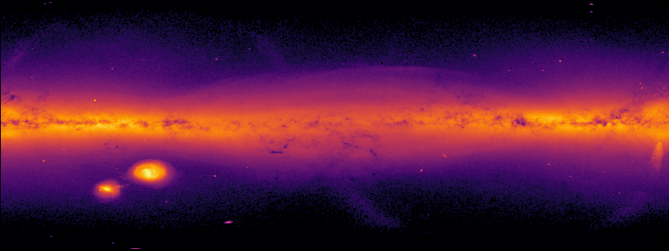Unveiling substructures at the edge of the Galaxy

The map revealed the existence of many previously unknown structures.
An international team of astronomers led by Chervin Laporte, a researcher of the Institute of Space Studies of Catalonia (IEEC – Institut d'Estudis Espacials de Catalunya) at the Institute of Cosmos Sciences of the University of Barcelona (ICCUB), has revealed a new map of the Milky Way’s outer disc using data from the ESA's space mission Gaia. The findings have been published in the journal Monthly Notices of the Royal Astronomical Society today.
The team analysed the Gaia motion data, available since December 2020, to identify coherent structures. The map revealed the existence of many previously unknown structures at the edge of the disc. It also gave a sharper global view of previously known structures. Numerical simulations predict such structures to be formed in the outer disc from past satellite interactions; however the sheer quantity of substructure revealed by this map was not expected and remains a mystery.
“Typically, this region of the Milky Way has remained poorly explored due to the intervening dust which severely obscures most of the Galactic midplane”, says Laporte. “While dust affects the luminosity of a star, its motion remains unaffected. As a result, one can use the star's motion to perform tomography of the Galaxy’s outermost regions”, he adds.


The images show the structure of tidal arms supposedly created by interaction with other satellite galaxies in the past of the Milky Way / Chervin Laporte (ICCUB – IEEC).
Our Galaxy is surrounded by 50 satellite galaxies and has engulfed numerous galaxies in its past. At present, the Milky Way is thought to have been perturbed by the Sagittarius dwarf galaxy which confirmed earlier theoretical models. However, in its more distant past it interacted with another intruder, the Gaia Sausage, which has now dispersed its debris into the stellar halo. Accordingly, the researchers formulated the hypothesis that these thin structures are remains of tidal arms from the Milky Way disc, which were excited at different times by various satellites.
The team has secured a dedicated follow-up programme with the WEAVE spectrograph to study the similarities / differences in stellar populations in each substructure. Future upcoming surveys (SDSS-V and PFS) will also shed light into their origins through complementary radial velocities, chemical abundances and potential stellar ages.
Press release made in collaboration with ICCUB Communication Office.
Links
More information
This research is presented in a paper entitled “Kinematics beats dust: unveiling nested substructure in the perturbed outer disc of the Milky Way”, by C. Laporte, S. E. Koposov and V. Belokurov, published in the journal Monthly Notices of the Royal Astronomical Society on 14 December 2021.
The Institute of Space Studies of Catalonia (IEEC — Institut d’Estudis Espacials de Catalunya) promotes and coordinates space research and technology development in Catalonia for the benefit of society. IEEC fosters collaborations both locally and worldwide and is an efficient agent of knowledge, innovation and technology transfer. As a result of 25 years of high-quality research, done in collaboration with major international organisations, IEEC ranks among the best international research centers, focusing on areas such as: astrophysics, cosmology, planetary science, and Earth Observation. IEEC’s engineering division develops instrumentation for ground- and space-based projects, and has extensive experience in working with private or public organisations from the aerospace and other innovation sectors.
IEEC is a private non-profit foundation, governed by a Board of Trustees composed of Generalitat de Catalunya and four other institutions that each have a research unit, which together constitute the core of IEEC R&D activity: the Universitat de Barcelona (UB) with the research unit ICCUB — Institute of Cosmos Sciences; the Universitat Autònoma de Barcelona (UAB) with the research unit CERES — Center of Space Studies and Research; the Universitat Politècnica de Catalunya · BarcelonaTech (UPC) with the research unit CTE — Research Group in Space Sciences and Technologies; the Spanish Research Council (CSIC) with the research unit ICE — Institute of Space Sciences. IEEC is a CERCA (Centres de Recerca de Catalunya) center.
Contacts
IEEC Communication Office
Barcelona, Spain
Ana Montaner and Sònia Bagudanch
E-mail: comunicacio@ieec.cat
Lead Researcher
Institut d’Estudis Espacials de Catalunya (IEE)
Institute of Cosmos Sciences of the University of Barcelona (ICCUB)
Barcelona, Spain
Chervin Laporte
E-mail: chervin.laporte@icc.ub.edu
